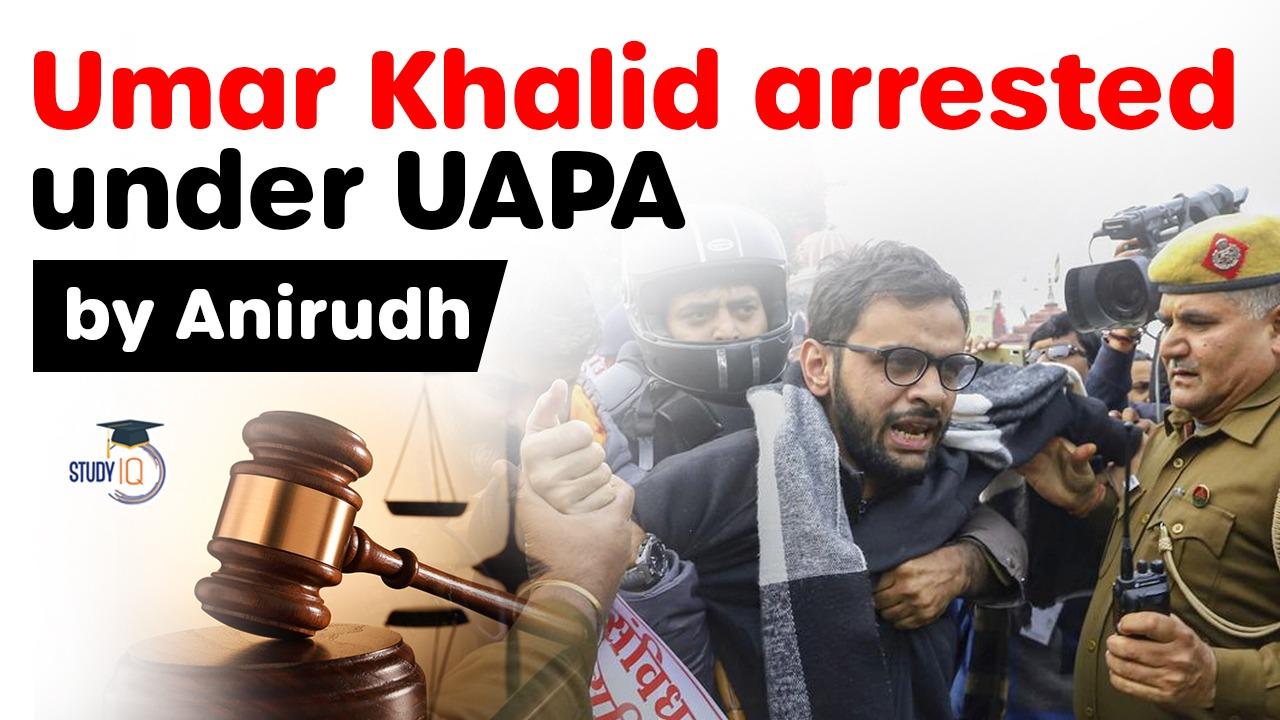Table of Contents

WHY IN NEWS
- Delhi Police on Monday got 10 days’ custody of former JNU student Umar Khalid, who had been arrested a day previously in a case registered under the Unlawful Activities (Prevention) Act (UAPA). Khalid is one of several young activists who have been booked in cases relating to the violence in Delhi in February.

WHAT IS THE UAPA, AND WHAT IS IT USED FOR?
- The UAPA is primarily an anti-terror law – aimed at “more effective prevention of certain unlawful activities of individuals and associations and for dealing with terrorist activities”.
- It was first promulgated in 1967 to target secessionist organisations, and is considered to be the predecessor of laws such as the (now repealed) Terrorist and Disruptive Activities (Prevention) Act (TADA) and Prevention of Terrorism Act (POTA).

- Following the last amendment in 2019, an individual can be designated a terrorist; only organisations could be designated earlier. UAPA cases are tried by special courts.
- The law has been used in cases other than those of conventional ‘terrorism’ or ‘terrorist acts’.
- UAPA cases have been filed against activists in the Bhima-Koregaon case; at least two journalists in Kashmir; former Congress municipal councillor Ishrat Jahan; Khalid Saifi of the organisation United Against Hate; Jamia Millia Islamia student Safoora Zargar; and now, Umar Khalid.
UAPA IS MUCH MORE STRINGENT THAN OTHER LAWS
- Safoora Zargar is the only one among the accused booked under UAPA who has been given bail. But she was granted relief on humanitarian grounds.

NO ANTICIPATORY BAIL… EXTENDED POLICE CUSTODY
- It is rare for an accused to get bail easily in a case under UAPA. The court can refuse bail if in its opinion the case is “prima facie” true. An accused cannot seek anticipatory bail, and the period of investigation can be extended to 180 days from 90 days on the public prosecutor’s request — which means the accused has virtually no chance of getting bail by default.
- In UAPA cases, the police custody can also be extended to 30 days as against the 15 days allowed in ordinary criminal cases.
- Section 438 of the Criminal Procedure Code (CrPC) provides for the provision of anticipatory bail
WHAT IS THE CASE REGISTERED AGAINST KHALID AND OTHERS?
- The investigation is based on FIR 59 of 2020, in which IPC Sections 302 (murder)ü 153A (promoting enmity between different groups on grounds ofü religion, etc.), 124A (sedition), and othersü have been included.
- The core of the police case is that the “communal riot incidents” of February 2020 in Delhi were “pre-planned” by Khalid and the others. Khalid is accused of giving provocative speeches and urging people to come out on the roads to ensure that the “propaganda of minorities in India are being persecuted” may get publicised during the visit of US President Donald Trump (on February 24-25).

WHICH PROVISIONS OF THE UAPA HAVE BEEN USED?
- Sections 13, 16, 17, and 18 of the UAPA were added to the case subsequently. The Act defines unlawful activity as any action — spoken or written words, signs, or visible representation — which is intended or supports any claim to bring about secession of any part of India or which incites anyone towards secession; disclaims, questions, disrupts or intends to disrupt the sovereignty and territorial integrity of India; and “which causes or is intended to cause disaffection against India”.
- Section 13 (“Punishment for unlawful activities”) provides for up toü seven years in prison.
- Section 16 (“Punishment for terrorist act”) specifies punishmentü with death or imprisonment for life.
- Section 17 provides punishment for raising funds for terrorist acts,ü Section 18 deals with conspiracy behind the terrorist act or “any actü preparatory to the commission of a terrorist act”.
IS DELHI POLICE JUSTIFIED IN INVOKING THE ANTITERROR LAW?
- Critics have argued that dissenting or protesting peacefully would not amount to causing “disaffection against India” ,.
- The police have told the court that the riots were a result of a bigger conspiracy to “overawe the government machinery”, and that the conspirators had a “specific purpose, object and mandate” to cause “disaffection and revolt against the Government of India”.
- The prosecution has argued that the aim of the protests was “to destroy, destabilise and disintegrate the Government of India in order to compel (it) to withdraw the Citizenship Amendment Act (CAA) and alleged National Register of Citizens.”
Latest Burning Issues | Free PDF






















 WhatsApp
WhatsApp